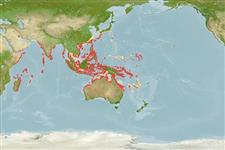Common names from other countries
Environment: milieu / climate zone / depth range / distribution range
экология
ассоциированный с рифами; пределы глубины 0 - 30 m (Ref. 98471). Subtropical; 36°N - 27°S, 43°E - 172°E (Ref. 848)
Indo-West Pacific: Yemen, Indonesia to Melanesia, north to Japan and south to Queensland, Australia.
Length at first maturity / Size / Вес / Возраст
Maturity: Lm ? range ? - ? cm
Formation: cerioid, with neat angular corallites up to 8 mm in diameter. Septa with 1 to 3 teeth. Mantle: thick and fleshy, usually covered with fine papillae. Color: gray, except in Japan where it is brick red or green (Ref. 848).
Occurs in protected reef environments and rocky foreshores (Ref. 848).
Life cycle and mating behavior
половая зрелость | размножение | нерест | икра | Fecundity | личинки
Members of the class Anthozoa are either gonochoric or hermaphroditic. Mature gametes are shed into the coelenteron and spawned through the mouth. Life cycle: The zygote develops into a planktonic planula larva. Metamorphosis begins with early morphogenesis of tentacles, septa and pharynx before larval settlement on the aboral end.
Основная ссылка
ссылки | координатор | соавторы
Veron, J.E.N. 2000. (Ref. 848)
Статус Красного Списка МСОП (Ref. 130435)
Статус СИТЕС (Ref. 108899)
Not Evaluated
Использование человеком
| FishSource |
инструменты
дополнительная информация
Возраст/РазмерыростЗависимость между длиной и массой телаЗависимость между длинамиморфологияличинкичисленность
ресурсы в Интернет
Estimates based on models
Preferred temperature
(Ref.
115969): 25.4 - 29.3, mean 28.6 (based on 2925 cells).
Категория цены
Unknown.
